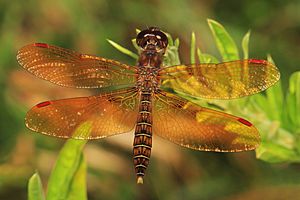Eastern amberwing facts for kids
Quick facts for kids Eastern amberwing |
|
|---|---|
 |
|
| Female | |
| Scientific classification | |
| Kingdom: | |
| Phylum: | |
| Class: | |
| Order: | |
| Family: |
Libellulidae
|
| Genus: |
Perithemis
|
| Species: |
P. tenera
|
| Binomial name | |
| Perithemis tenera (Say, 1840)
|
|
 |
|
| Range of P. tenera | |
The eastern amberwing (Perithemis tenera) is a small and fascinating dragonfly. It belongs to the Libellulidae family, which are often called skimmer dragonflies. These tiny insects are found across the eastern and central parts of the United States.
Contents
What is an Eastern Amberwing?
The eastern amberwing is a very small dragonfly. It usually grows to be no more than 25 millimeters long. That's about the size of a quarter! Male eastern amberwings have bright orange or amber-colored wings. Both male and female amberwings have a small red spot on their wings. This spot is called a pterostigma.
Where Do They Live?
The common name "eastern amberwing" tells us where these dragonflies are found. They live mainly in the eastern United States. However, you can also find them stretching westward into the central parts of the country. The scientific name, tenera, means "delicate." This name fits them well because of their small size.
Amazing Wasp Mimicry
One of the most interesting things about the eastern amberwing is how it pretends to be a wasp. This is a clever trick to stay safe from predators. The dragonfly has yellow and brown stripes on its body. These stripes look a lot like a wasp's markings.
When an eastern amberwing lands, it will wiggle its body and wings. This movement makes it look even more like a wasp. Predators, like birds or frogs, see this and usually decide to stay away. They don't want to get stung by a wasp!
Courtship and Reproduction
Male eastern amberwings have a special way to attract females. This is called a courtship ritual. When a female dragonfly comes near a male's territory, he will try to impress her.
The male will lead the female to a good spot for laying eggs. Then, he will hover above this spot. He will make his wings whir very fast and raise his abdomen. This display helps convince the female that his chosen spot is perfect for their future young.
Gallery



